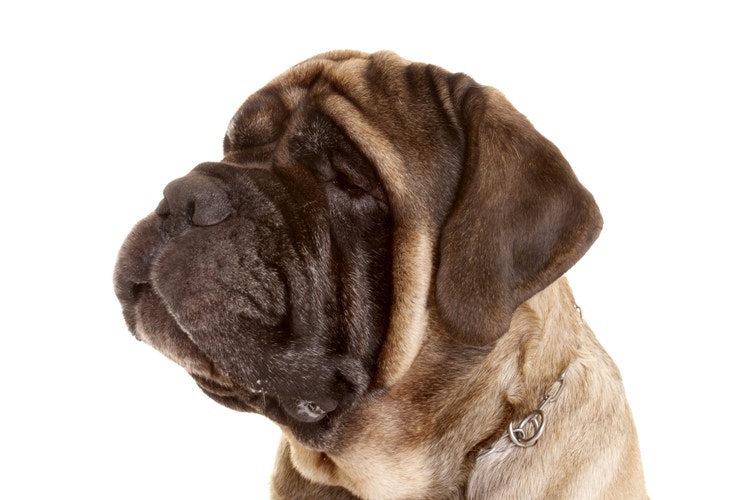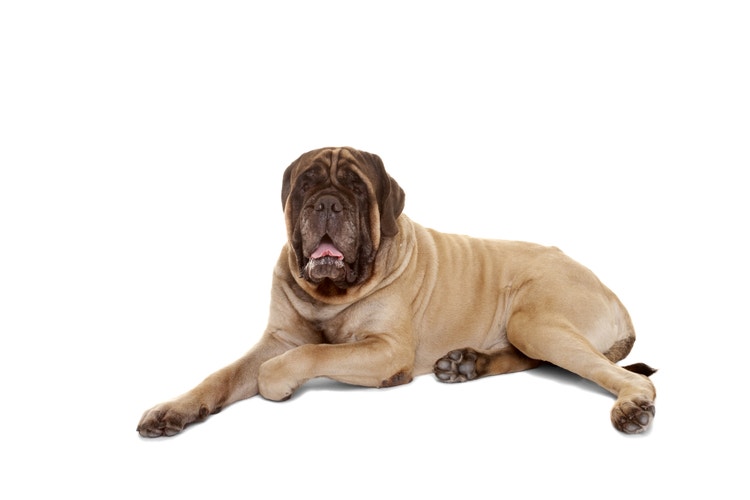
Old English Mastiff


Where Are English Mastiffs From?
English Mastiffs date back to the first millennium BC, when Phoenician traders brought the Mastiff’s ancestors on trading ships to the British Isles. When the Roman Empire landed in Britain in 55 BC, Mastiffs were already cherished by the locals. The Romans were in awe by the strength of this huge dog breed and they were exported for use in the Colosseum, making them the only tame animal to fight against lions and other wild animals.
Mastiffs were exploited for their abilities in dog-fighting, bear-baiting, and bull-baiting for centuries. However, their sweet personalities as companions popularized them in the Industrial Revolution. Mastiffs were among the first dogs to come the New World on the Mayflower. They became a popular American dog breed and were even used to pull munition carts on the front line during WWI and WWII. The modern Mastiff was re-established in 1929 by the American Kennel Club and has been beloved ever since.
Caring for an Old English Mastiff
How Much Should I Feed My English Mastiff?
How Much Should I Feed My English Mastiff?
English Mastiffs have a voracious appetite and require a high daily caloric intake to maintain their large size. Owners should budget accordingly for large quantities of dry food.
Do English Mastiffs Shed a Lot?
Do English Mastiffs Shed a Lot?
Mastiffs shed a lot and will need regular brushing and bathing to maintain their undercoat. A specialized brush to remove the undercoat is often used.
Are English Mastiffs Healthy Dogs?
Are English Mastiffs Healthy Dogs?
Like most large breeds, the Mastiff is predisposed to a host of associated giant breed dog diseases. Their sheer size makes veterinary care expensive and owners should be prepared for the accompanying medical costs. It is important to note that their lifespan is also shorter than may be expected, ranging from 6 – 9 years. They will need to have a gastropexy performed at the time of neuter or spay to prevent gastric dilatation volvulus or “bloat.” Mastiffs also have many orthopedic conditions and may need to have surgery to address them. Heart disease, specifically a disease called Dilated Cardiomyopathy, can also occur at a young age and may require a full cardiac work-up and medications for life.
Mastiffs are predisposed to: gastric torsion, hip dysplasia, ruptured cranial cruciate ligament, dilated cardiomyopathy, cataracts, entropion, cherry eye, corneal dystrophy, urolithiasis, arthritis, elbow dysplasia, osteosarcoma, and oligodendroglioma.
Can You Train an English Mastiff?
Can You Train an English Mastiff?
Diligent breeding has taken the persona of the “Old English Mastiff fighting dog” and turned it into an affectionate and sensitive best friend. Mastiffs are extremely good with children and tolerate a lot of poking and prodding. They are loyal and faithful, but can be aggressive toward other household pets. They can be wary of strangers and may require a firm hand in public on a leash.
Do English Mastiffs Need Lots of Exercise?
Do English Mastiffs Need Lots of Exercise?
The sheer size of the Mastiff necessitates more space than a smaller dog. However, Mastiffs are notoriously lazy and often prefer to lounge around and go for slow walks. They require little more than a few 30-minute walks per day. Because of their large size, they’re not athletic companions and can overheat easily. Therefore, they should be encouraged to take slow walks to maintain their joints and prevent arthritis.
What Are the Physical Characteristics of an English Mastiff?
English Mastiff Facts
Other Breeds to Explore
References
- Gough, Alex, Alison Thomas, and Dan O’Neill. Breed Predispositions to Disease in Dogs and Cats. John Wiley & Sons, 2018.
- Mastromarino, Mark A. “”Teaching Old Dogs New Tricks: The English Mastiff and the Anglo‐American Experience.”” The Historian 49.1 (1986): 10-25.
- Morris, Desmond. Dogs: The Ultimate Dictionary of Over 1,000 Dog Breeds. Trafalgar Square, 2002.
- American Kennel Club. The Complete Dog Book. Random House Digital, Inc., 2006.
- Wynn, M. B. History of The Mastiff-Gathered From Sculpture, Pottery, Carvings, Paintings and Engravings; Also From Various Authors, With Remarks On Same (A Vintage Dog Books Breed Classic). Read Books Ltd, 2011.


